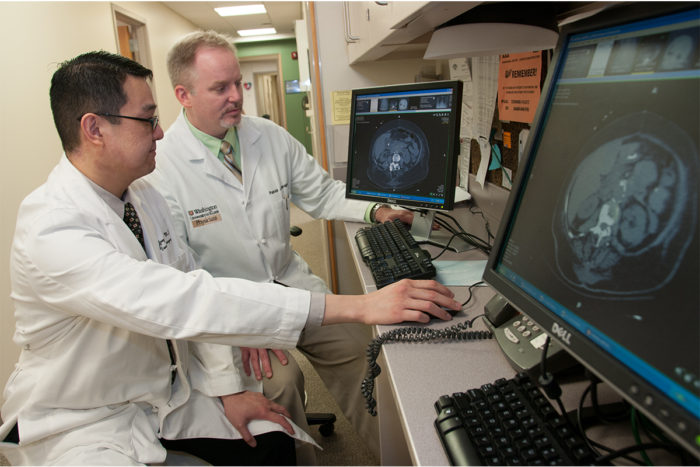Procedure to open blocked carotid arteries tested
Testing is beginning on an investigational device designed to open blocked arteries in patients who are ineligible for traditional surgery

Jeffrey Jim, MD, (left) and Patrick Geraghty, MD, are working to improve vascular surgery outcomes.
Doctors at Washington University School of Medicine are investigating a minimally invasive procedure to open blocked carotid arteries in patients whose poor health or advanced age makes the traditional surgery too risky.
The clinical study is part of a global, multicenter trial evaluating the safety and effectiveness of transcarotid stenting with dynamic flow reversal, a new technique and device designed for high-risk patients with carotid artery disease, a condition that restricts blood flow to the brain and increases the risk of stroke.
The two carotid arteries in the neck supply blood to the brain and can become clogged with plaque in the same way that arteries in the heart can become blocked. More than 300,000 people in the United States are diagnosed with carotid artery blockages every year. Left untreated, blockages can stop blood flow, and plaque debris can dislodge to the brain, causing a potentially disabling stroke.
The current surgical or “open” procedure used to clean out a clogged carotid artery is generally considered safe and effective but requires a large incision along the patient’s neck. The procedure is usually done under general anesthesia and carries surgical risks that may make it unsuitable for high-risk patients.
Although a less invasive alternative has been available for years, it carries a risk of stroke. Called carotid artery stenting, the procedure involves inserting a mesh stent through an artery in the groin and threading it into the carotid artery. Because the stent can knock plaque loose, a tiny umbrella-like filter is first inserted through the blocked artery to catch this debris and stop it from entering the brain. But the filter itself still carries a risk of stroke because it, too, can dislodge plaque.
Reduced chances of complications
“The new technique and device system may reduce the chances of these complications,” said Washington University vascular surgeon Jeffrey Jim, MD, who performs the procedure at Barnes-Jewish Hospital.
“We deliver a stent directly into the carotid artery from a small incision in the neck,” said Jim, an assistant professor of surgery. “It is a shorter and potentially safer route than stenting via the groin. And it can be done using local anesthetic.”
The “dynamic flow reversal” device temporarily reverses blood flow in the blocked artery, diverting it away from the brain and into tubing set up outside the body. Filters in this tubing remove any plaque debris knocked loose during placement of the stent. The tubing then directs the blood back into the body through a vein near the groin. Because blood enters the brain through multiple arteries, patients are not adversely affected by this temporary flow reversal in a single vessel.
Washington University School of Medicine is one of 25 centers around the world participating in the clinical study, which is expected to enroll 140 patients in the United States.
The study is funded by Silk Road Medical, developers of the transcarotid stenting with dynamic flow reversal system.
For more information about the study, contact Theresa LaRose, clinical research coordinator, at 314-362-6257.






